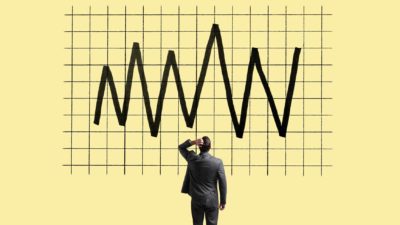On Sunday night and Monday morning, before the ASX opened for trade, I tweeted and posted on Facebook.
See, yesterday's falls were always likely – the US market fell heavily on Friday night, and the ASX futures were down 1%.
So, as I'm wont to do from time to time, I wanted to remind my followers that volatility is common (if often unwelcome), but that in the context of long term results, it's almost nothing.
See, our evolved human brains deal very well with the present, but very poorly with the long term future. So we overweight current events, but underweight the result of decades of growth.
And we don't think well in compound terms.
Investing well is essentially the ability to learn to control and subjugate our evolutionary impulses.
And, as I often do, I shared the Vanguard Index Chart, which shows 30 years' worth of returns from different asset classes (and inflation).
Which prompted lots of positive feedback and thanks from followers.
And some criticism.
Now, to be 100% clear, the Vanguard chart isn't infallible.
And there's no guarantee that the future will look like the past.
That chart isn't an argument-ender, nor is it intended (by me, or I assume, by Vanguard) to be so.
It's an arbitrary period of time, during which certain things happened (and others didn't) and the result is, well, the result.
As you can see.

Very, very impressive.
But it could have been different.
Perhaps markedly so.
But the data is the data.
And the key point?
Over long time frames:
– The share market has tended to create vast wealth
– Dollar cost averaging has been incredibly successful
– Daily / weekly / monthly volatility tends to be smoothed out
– Crises, threats and crashes happen
– So do booms, exuberance and recklessness; but
– The share market has been a very good place to invest
And yet.
And yet, I was taken to task by a few followers.
Now, my aim is not to shame them. Or criticise them. Or use the bully-pulpit to have the last say.
But I do want to address their points, as I assume they're views also held by some others who read these things.
One common one is "Well, that's a convenient timeframe, because over the last 30 years…" then followed by a range of things that could have (maybe even did) support share prices over that timeframe.
Except that the last 30 years is pretty similar to the 90-odd before that.
Another is "Well, what about inflation?" – which… is on the chart, too.
"I don't have 30 years" is one critique. Which… most people under 65 shouldn't say. Because, on average, they do. And those over 65 should consider, but not assume.
But the bigger question is: so, what are you going to do differently (that works just as well), if not invest for the long term? Day trade? Put it all in crypto? Play the pokies? Oh, I'm not dismissing the question, or the very real uncertainty – I just don't know of a more effective investment approach.
I can't directly advise those people (we're not allowed to give personal advice) but my general advice is to have enough cash on the sidelines to cover living expenses for 3-5 years in retirement (unless your portfolio is large enough that the dividends can do that for you). And then I'd put the rest in a diversified share portfolio, unless you know of a better asset class in which to invest.
"I've never seen someone leave money alone for 30 years" said another. Which may be true, but it doesn't mean you shouldn't. Or that, at the very least, you should structure your finances so that you can withdraw some money at a time of your – rather than the market's – choosing. See my comments above about money to live on.
"It's not up much since [usually 2007]" is another criticism I hear. Which is true. –ish.
It's actually up quite a lot (those people usually look only at the S&P/ASX 200 Index (ASX: XJO), which doesn't include the value of reinvested dividends – which is like saying your bank balance didn't go up, because you ignored the interest!)
But also, they're choosing an arbitrary peak. As if that's the only time someone would have invested money.
Essentially, they're saying: "Ah, but what if I only ever invested on November 1, 2017?"
Well, first, you'd be the unluckiest bastard in the world. Second, I've never met that person. Third, the rest of us invested before November 2017, in November 2017, and/or since November 2017, buying at lower prices most of the rest of that time. It's an easy mistake to make, but they're missing the point if they're just comparing today's prices with a past, arbitrary peak.
"But what about taxes?" said another. (The chart doesn't include taxes or brokerage fees.) Yes, taxes are something we should consider. But if you're not selling, and if you get franking credits for most of the dividends you receive, depending on your tax bracket you may get a refund (increasing your returns, rather than reducing them), pay no tax, or pay some on top of the franking credits. Which means a chart like that can't include taxes – because everyone's situation is different – but also that it kinda misses the point.
If you're looking at that chart saying 'Well, the return for Australian shares might be 8.2% and not 9%'… you could be right.
In which case?
In which case you'd still have made a truckload of money.
I think – with genuine respect for my interlocutors – they're missing the forest for the trees.
Sure, you could reconstruct that chart using different timeframes (some are already there in the box in the bottom right corner, by the way) or using different tax assumptions.
You could make allowances, positive or negative, for the results.
You could twist yourself in knots trying to recast the numbers.
But you'd miss the point.
Which is?
I'm glad you asked!
But I've already given that away.
Whether the future is better or worse than the past is unknowable.
The point: 120+ years of market history suggests that investing in listed equities (particularly in Australia and the US) has created extraordinary wealth.
And now, you have a choice.
You can pick holes in the data, and in doing so, focus on that.
Or you can accept that past performance is no guarantee (and it's not), and believe that the forces that shaped the last century of share market performance are likely going to continue in place for the foreseeable future.
You know, like progress. Human ingenuity. New solutions for new and existing problems. New wants and new needs, met by businesses with new products and new services.
Because that's really the point of the chart.
That progress is real. That the share market tends to capture most of the largest (financial) value creators. And that we continue to benefit, as shareholders.
And that, while our brains struggle to conceptualise the idea of 'compounding', you really can create extraordinary wealth through investing in public companies (either individually or, as this chart shows, via an ETF).
So now you know.
And the choice you make is important.
Me?
I think it's probable that the course of financial history will be more or less like the past.
Lots of volatility.
Some bad days, weeks and years. Even some flat decades, as uncomfortable as that is to say.
But overall?
Given the choice to invest, or not to invest?
I'm investing. Regularly and often. And I expect it'll deliver very nice compound gains despite – perhaps even in spite of – the arguments advanced as to why the chart isn't perfect.
Here's to wonderfully imperfect wealth creation!
Fool on!









